After wresting power from her husband, Catherine the Great ruled Russia for 34 years, styling herself as the heir to her westernizing grandfather-in-law Peter the Great. In parallel with military campaigns that added large parts of Poland and the Crimean Peninsula to Russia's Empire, the German-born Tsarina waged a cultural offensive, buying Western art by the boatload.
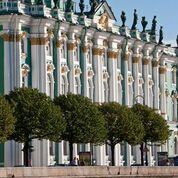
The Hermitage Museum, the Winter Palace in Summer, from across the Neva River, St Petersburg Photo: Andrey Terebenin
With her first acquisition in 1764 -- some 300 canvases earmarked for political rival Frederick the Great of Prussia -- Catherine II founded the State Hermitage Museum in St. Petersburg. On the heels of the museum's 250th birthday, over 450 of her art works star in "Masterpieces of the Hermitage: The Legacy of Catherine the Great" at the National Gallery of Victoria in Melbourne, Australia through November 8.
Organized by Mikhail Dedinkin, deputy head of the Hermitage's department of Western European art, and Ted Gott, senior curator, International Art at the NGV, the exhibition explores Catherine's wide ranging patronage with some 100 paintings, 80 drawings and her dazzling silver and porcelain commissions intended to trumpet Russia's wealth. The art unfolds in a series of richly decorated galleries that evoke the storied Hermitage.
Dripping ermine and regalia, Catherine herself greets visitors in the opening gallery in an official portrait by Sweden's Alexander Roslin, one of many artists she recruited to St. Petersburg to fashion her enlightened image. She didn't hesitate to have her face "photo shopped" with younger, more attractive versions. In today's parlance, she encouraged her image to go viral, on everything from snuffboxes and medallions to tapestries and portrait busts.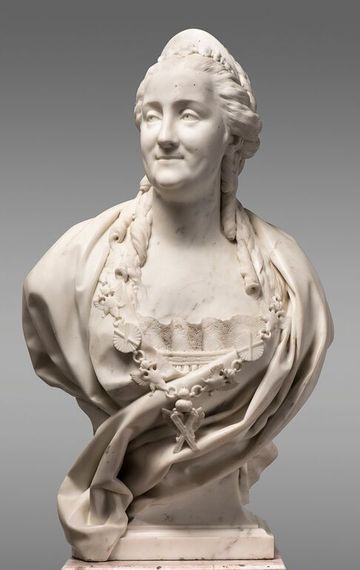
Jean-Antoine HOUDON French 1741-1828 Catherine II 1773 marble 90.0 x 50.0 x 32.0 cm The State Hermitage Museum, St Petersburg (Inv. no. Н.ск. 1676) Transferred from the Stroganov Palace, Leningrad, 1928
Initially, Catherine's art collecting was a political pursuit, part of a calculated strategy to transform Russia from northern backwater to European superpower. Describing herself as a "glutton" not a connoisseur, she began devouring auction catalogues along with illustrated books on art and architecture. Before long, the hands-on Empress was doling out advice to her Paris art scouts Denis Diderot and Frederic Melchior Grimm, and sending sketches to her favorite architect with detailed instructions.
So was Catherine the Great a "glutton" or a connoisseur? "A bit of both," according to NGV curator Laurie Benson. "She certainly knew more than she was letting on," says Benson. "She even bought contemporary work by artists who were virtually unknown. Many later became recognized masters, such as the English painter Joseph Wright of Derby. So, she bought work she liked and not just art with a big name attached."
Fittingly, we meet Catherine II surrounded by three of her greatest passions: architecture, cameos, and antiquity. Consumed by what she dubbed a "diabolical" building mania, Catherine transformed swampy St. Petersburg into a splendid neoclassical capital with a distinctive Russian atmosphere. French émigré portraitist Elizabeth Vigée Le Brun likened the neoclassical buildings lining the Neva River to ancient temples. On view are drawings by three of Catherine II's hand-picked designers -- Scotsman Charles Cameron, Italian Giacomo Quarenghi, and Russian Yury Velten.

Grand Duchess Maria FYODOROVNA (engraver) Russia 1795-1828 RUSSIA (manufacturer) Catherine the Great as Minerva, cameo 1789 jasper, gold 6.5 x 4.7 cm The State Hermitage Museum, St Petersburg (Inv. no. К 1077) Acquired 1789
Suffering from "cameo fever," Catherine amassed a staggering 10,000 tiny carved gems from antiquity and the Renaissance to her own day. Examples of this obsession are on view -- including a jasper cameo portrait of Catherine as Minerva, a 60th birthday present carved by her daughter-in-law, along with Head of Medusa by London's James Tassie. Also on display are objects from the Sèvres Cameo Service, a gift to Gregory Potemkin, Catherine's soul mate who many historians believe she secretly married. Combining her love of antiquity and cameos, the spectacular 700-piece service nearly bankrupt the prestigious French factory.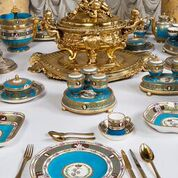
SÈVRES PORCELAIN FACTORY, Sèvres (manufacturer) France est. 1756 Cameo Service 1778-79 porcelain (soft-paste), gilt The State Hermitage Museum, St Petersburg
The next four galleries, organized by Italian, Flemish, Dutch and French schools, give visitors a real sense of Catherine II's taste in paintings. From her spectacular acquisition in 1772 of the renowned collection of Paris banker Pierre Crozat came many Hermitage masterworks, including the sensuous "Portrait of a young woman" by Titian. The sitter's soft fur and luxurious green velvet robe illustrate the virtuoso brushwork and splendid palette that catapulted the Venetian Renaissance painter to stardom.
The strength of Catherine's picture gallery was Flemish and Dutch art, as the show's six Rubenses, three Van Dycks, three Rembrandts and Frans Hals canvas attest. Throughout her reign, Catherine lavished her "favorites" with art and palaces, often purchasing the works and properties back either after their deaths or the end of the relationships. This was the case with Rembrandt's gem-like "Young woman trying on earrings" acquired for her beloved Alexander Lanskoy whose death at age 26 left Catherine devastated.

REMBRANDT Harmensz. van Rijn Dutch 1606-69 Young woman trying on earrings 1657 oil on wood panel 39.5 х 32.5 cm The State Hermitage Museum, St Petersburg (Inv. no. ГЭ-784) Acquired from the collection of the Comte de Baudouin, Paris, 1781
Along with paintings from Saxony's Heinrich von Brühl and Austria's Carl Cobenzl came drawings and there are splendid examples here by Albrecht Dürer, Rembrandt, Rubens, Nicolas Poussin, and Jean-Baptist Greuze. Thanks to Catherine II, the Hermitage boasts some 120 French crayon portraits, the largest such collection outside France. One of the highlights is on view here -- the black and red chalk "Portrait of Charles IX" by Francois Clouet. 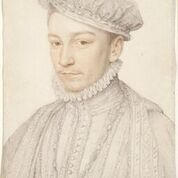
Francois CLOUET French (c. 1516)-1572 Portrait of Charles IX 1566 black and red chalk 33.1 x 22.5 cm (sheet) The State Hermitage Museum, St Petersburg (Inv. no. OР2893) Acquired from the collection of Count Cobenzl, Brussels, 1768
Parisian sculptor Jean-Antoine Houdon, known for his expressive portraits of Enlightenment celebrities, is represented by busts of Catherine and French naturalist Comte de Buffon who she greatly admired. There are also two marble busts by Marie-Anne Collot of French philosophes Voltaire and Denis Diderot, both of whom sang Catherine's praises. Though she gets little credit, Collot modeled the head of Peter the Great for St. Petersburg's iconic equestrian statue, known as the Bronze Horseman. Catherine recognized Collot's talent and commissioned numerous portrait busts.
Catherine established the Hermitage in just three decades by buying entire art collections. As Laurie Benson puts it, she distinguished herself from rival collectors by the sheer volume and quality of her acquisitions. "Nobody before or since her time acquired art on the scale that she achieved," says Benson. "She wanted to create a Louvre-standard gallery in Russia in her lifetime."
One of Catherine's finest and most controversial buys came in 1779 when she snatched some 200 Old Masters assembled earlier in the century by Robert Walpole, England's first prime minister. A gallery featuring Walpole highlights includes three canvases by Peter Paul Rubens' gifted, prolific pupil Anthony van Dyck who produced flattering portraits of England's royals and their courtiers. One of his most charming is "Portrait of Philadelphia and Elizabeth Wharton", the young daughters of an avid patron. 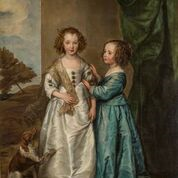
Anthony van DYCK Flemish 1599-1641 Portrait of Philadelphia and Elizabeth Wharton 1640 oil on canvas 162.0 х 130.0 cm The State Hermitage Museum, St Petersburg (Inv. no. ГЭ-533) Acquired from the collection of Sir Robert Walpole, Houghton Hall, 1779
Though Catherine's main interest was Western art, she was also smitten by eastern "exotica" which she displayed at the Winter Palace. Against a backdrop of turquoise and salmon wallpaper, the final gallery features exquisite chinoiserie and Chinese decorative arts. These include intricate gold and silverware and Catherine's mirrored Chinese toilette set made of filigree, silver, and mother of pearl.
"This museum forms a corner," Catherine wrote her confidant Melchior Grimm, "which you enter through China, to get to China you got through Turkey, which in turn is entered via Persia...here everything is imbued with the ambrosia of Asia."
For more information, visit http://www.ngv.vic.gov.au/exhibition/masterpieces-from-the-hermitage/
Susan Jaques is the author of 'The Empress of Art: Catherine the Great and the Transformation of Russia' available April, 2016 from Pegasus Books.
